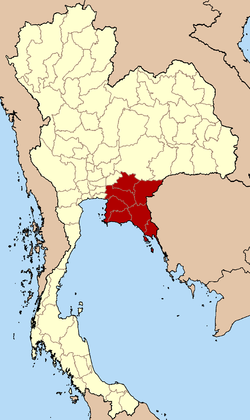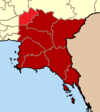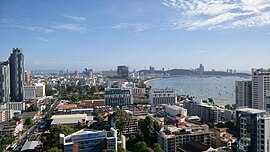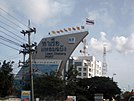Eastern Thailand
Eastern Region | |
|---|---|
|
From upper-left to lower-right:Pattaya in daytime,Port of Laem Chabang,Khao Khitchakut,Ko ChangandWat Sothonwararam | |
 Eastern Region in Thailand | |
| Largest city | Chaophraya Surasak CityandPattaya |
| Provinces | |
| Area | |
| • Total | 34,481 km2(13,313 sq mi) |
| Population (2019)[2] | |
| • Total | 4,841,806 |
| • Density | 140/km2(360/sq mi) |
| GDP | |
| • Total | US$98.2 billion (2019) |
| Time zone | UTC+7(Thailand) |
Eastern Thailandis a region ofThailandborderingCambodiaon the east,Northeastern Thailandin the north, andcentral Thailandon the west.
Geography
[edit]Eastern Thailand lies between theSankamphaeng Range,which forms a natural border with theKhorat Plateauto the north and theGulf of Thailandto the south. The geography of the region is characterised by short mountain ranges (collectively grouped under theChanthaburi Range) alternating with small basins of short rivers which drain into the Gulf of Thailand. Between the Chanthaburi and Sankamphaeng mountains lies the basin of theBang Pakong Riversystem.
Fruit is a major component of agriculture in the area, and tourism plays a strong part in the economy. The region's coastal location has helped promoteeastern seaboardindustrial development, a major factor in the economy of the region.[4]
Islands off Eastern Thailand's coast includeKo Sichang,Ko Lan,Ko Samet,andKo Chang.
National parks
[edit]Within the eastern region there are some eightnational parks.Pang Sida National Parkcovering 844 km2in Sa Kaeo province, it constitutes a part of theDong Phayayen-Khao Yai Forest ComplexUNESCO World Heritage Site, covering in total around 6,100 km2.The total forest parent area is 8,205 km2(3,168 sq mi) or 22.4 percent of this eastern region area (incl. Nakhon Nayok province).[1]Mu Ko Chang National Parkin Trat province includes 85 per cent of Thailands second largest island Ko Chang. The beaches on the western coast of Ko Chang have been excluded from the national park for reason of facilitating the tourism industry.Mu Ko Samet National Parkin Rayong province is just 6 km long by 3 km wide with beaches covered with some of the finest white sand in the country.
Administrative divisions
[edit]According to thesix geographical regionsestablished by the National Research Council of Thailand, the eastern region includes seven provinces.

TheThai Meteorological Department(TMD), theOffice of the National Economic and Social Development Council(NESDC)[5]andRoyal Forest Department(RFD) also include province Nakhon Nayok in the Eastern region.

| Flag | Seal | Province | Capital | DOPA | Popul. | Area (km2) |
Dens. | ISO | |
|---|---|---|---|---|---|---|---|---|---|

|

|
1 | Chonburi | Chonburi | 9 | 1,558,301 | 4,508 | 346 | TH-20 |

|

|
2 | Rayong | Rayong | 50 | 734,753 | 3,666 | 201 | TH-21 |

|

|
3 | Chanthaburi | Chanthaburi | 7 | 537,698 | 6,415 | 84 | TH-22 |

|

|
4 | Trat | Trat | 16 | 229,958 | 2,866 | 78 | TH-23 |

|

|
5 | Chachoengsao | Chachoengsao | 8 | 720,113 | 5,169 | 139 | TH-24 |

|
6 | Prachin Buri | Prachin Buri | 31 | 494,680 | 5,026 | 99 | TH-25 | |

|

|
7 | Sa Kaeo | Sa Kaeo | 63 | 566,303 | 6,831 | 83 | TH-27 |
Note:Populationis based on "Statistics, population and house statistics for the year 2019" from Registration Office Department of the Interior. Reference date is 31 December 2019.[2]
Areais based on "Thailand boundary from Department of Provincial Administration.[1]
Economy
[edit]For fiscal year 2018, Eastern Thailand Region had a combined economic output of 3,026 trillion baht (US$97.6 billion), or 18.5 percent of Thailand's GDP. Rayong province had an economic output of 1.045 trillion baht (US$33.7 billion). This amounted to a per-capita Gross Provincial Product (GPP) value of 1,067,449 baht (US$34,434), almost double the GPP per-capita of the three following provinces in the ranking.[6]
| Rank | Province | GPP (million baht) |
Population (x 1000) |
GPP per capita (baht) |
|---|---|---|---|---|
| 1 | Rayong | 1,045.7 | 980 | 1,067,449 |
| 2 | Chonburi | 1,030.9 | 1,819 | 566,801 |
| 3 | Prachin Buri | 319.0 | 621 | 513,789 |
| 4 | Chachoengsao | 386.6 | 823 | 469,539 |
| 5 | Chanthaburi | 120.2 | 553 | 217,393 |
| 6 | Trat | 43.1 | 267 | 161,322 |
| 7 | Nakhon Nayok | 30.2 | 259 | 116,717 |
| 8 | Sa Kaeo | 50.8 | 630 | 80,716 |
| Eastern region | 3,026,495 | 5,951 | 508,568 |
Graphs are unavailable due to technical issues. There is more info onPhabricatorand onMediaWiki.org. |
Languages
[edit]The main language of Eastern Thailand isCentral Thai languagebut alsoregionalism.Krungthep dialect (dominant variant) is spoken amongThai Chinesecommunities, that isEEC area(such as inChonburi,Siracha,Pattaya,Padriew,Bangpakongetc.), dialect from Prachinburi Province pretty similar with Ayutthaya dialect (traditional working class dialect inBangkok), while the Rayong dialect and Chantaburi dialect are pretty similar with Suphanburi dialect (another dialect in Central Thailand).
Isan languageare minority status in Eastern Thailand, most are spoken in the eastern part ofPrachinburiand upper part ofSa Kaeo Provinces,this is the same variant as the Khonkaen dialect (Standard Lao language). Khmer language in Eastern Thailand is mostly spoken among older generation in Chantaburi and today becomeendangered language.
See also
[edit]References
[edit]- ^abc"ตารางที่ 2 พี้นที่ป่าไม้ แยกรายจังหวัด พ.ศ.2562"[Table 2 Forest area Separate province year 2019]. Royal Forest Department (in Thai). 2019.Retrieved6 April2021,information, Forest statistics Year 2019, Thailand boundary from Department of Provincial Administration in 2013
{{cite web}}:CS1 maint: postscript (link) - ^abรายงานสถิติจำนวนประชากรและบ้านประจำปี พ.ส.2562[Statistics, population and house statistics for the year 2019]. Registration Office Department of the Interior, Ministry of the Interior.stat.bora.dopa.go.th(in Thai). 31 December 2019. Archived fromthe originalon 14 June 2019.Retrieved26 February2020.
- ^"Gross Regional and Provincial Product, 2019 Edition".<>.Office of the National Economic and Social Development Council (NESDC). July 2019.ISSN1686-0799.Retrieved22 January2020.
- ^Eastern Seaboard Development Programme - RayongArchivedMarch 8, 2016, at theWayback Machine
- ^"National account".p. 37. Archived fromthe originalon 4 August 2019.Retrieved6 August2019.
- ^Phitsanulok Provincial Statistical Report 2562-2019: Economic Statistics - National Accounts. Phitsanulok Provincial Statistical Office (Report). National Statistical Office (NSO). 2020. pp. 93–94.ISSN1905-8314.
External links
[edit] Eastern Thailandtravel guide from Wikivoyage
Eastern Thailandtravel guide from Wikivoyage







